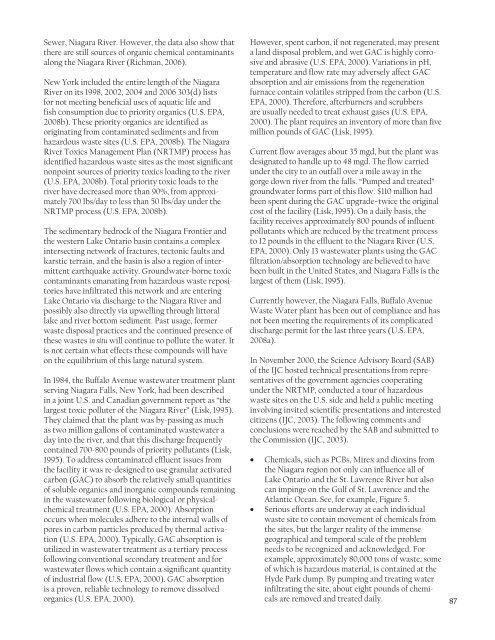Groundwater in the Great Lakes Basin
Groundwater in the Great Lakes Basin
Groundwater in the Great Lakes Basin
Create successful ePaper yourself
Turn your PDF publications into a flip-book with our unique Google optimized e-Paper software.
Sewer, Niagara River. However, <strong>the</strong> data also show that<br />
<strong>the</strong>re are still sources of organic chemical contam<strong>in</strong>ants<br />
along <strong>the</strong> Niagara River (Richman, 2006).<br />
New York <strong>in</strong>cluded <strong>the</strong> entire length of <strong>the</strong> Niagara<br />
River on its 1998, 2002, 2004 and 2006 303(d) lists<br />
for not meet<strong>in</strong>g beneficial uses of aquatic life and<br />
fish consumption due to priority organics (U.S. EPA,<br />
2008b). These priority organics are identified as<br />
orig<strong>in</strong>at<strong>in</strong>g from contam<strong>in</strong>ated sediments and from<br />
hazardous waste sites (U.S. EPA, 2008b). The Niagara<br />
River Toxics Management Plan (NRTMP) process has<br />
identified hazardous waste sites as <strong>the</strong> most significant<br />
nonpo<strong>in</strong>t sources of priority toxics load<strong>in</strong>g to <strong>the</strong> river<br />
(U.S. EPA, 2008b). Total priority toxic loads to <strong>the</strong><br />
river have decreased more than 90%, from approximately<br />
700 lbs/day to less than 50 lbs/day under <strong>the</strong><br />
NRTMP process (U.S. EPA, 2008b).<br />
The sedimentary bedrock of <strong>the</strong> Niagara Frontier and<br />
<strong>the</strong> western Lake Ontario bas<strong>in</strong> conta<strong>in</strong>s a complex<br />
<strong>in</strong>tersect<strong>in</strong>g network of fractures, tectonic faults and<br />
karstic terra<strong>in</strong>, and <strong>the</strong> bas<strong>in</strong> is also a region of <strong>in</strong>termittent<br />
earthquake activity. <strong>Groundwater</strong>-borne toxic<br />
contam<strong>in</strong>ants emanat<strong>in</strong>g from hazardous waste repositories<br />
have <strong>in</strong>filtrated this network and are enter<strong>in</strong>g<br />
Lake Ontario via discharge to <strong>the</strong> Niagara River and<br />
possibly also directly via upwell<strong>in</strong>g through littoral<br />
lake and river bottom sediment. Past usage, former<br />
waste disposal practices and <strong>the</strong> cont<strong>in</strong>ued presence of<br />
<strong>the</strong>se wastes <strong>in</strong> situ will cont<strong>in</strong>ue to pollute <strong>the</strong> water. It<br />
is not certa<strong>in</strong> what effects <strong>the</strong>se compounds will have<br />
on <strong>the</strong> equilibrium of this large natural system.<br />
In 1984, <strong>the</strong> Buffalo Avenue wastewater treatment plant<br />
serv<strong>in</strong>g Niagara Falls, New York, had been described<br />
<strong>in</strong> a jo<strong>in</strong>t U.S. and Canadian government report as “<strong>the</strong><br />
largest toxic polluter of <strong>the</strong> Niagara River” (Lisk, 1995).<br />
They claimed that <strong>the</strong> plant was by-pass<strong>in</strong>g as much<br />
as two million gallons of contam<strong>in</strong>ated wastewater a<br />
day <strong>in</strong>to <strong>the</strong> river, and that this discharge frequently<br />
conta<strong>in</strong>ed 700-800 pounds of priority pollutants (Lisk,<br />
1995). To address contam<strong>in</strong>ated effluent issues from<br />
<strong>the</strong> facility it was re-designed to use granular activated<br />
carbon (GAC) to absorb <strong>the</strong> relatively small quantities<br />
of soluble organics and <strong>in</strong>organic compounds rema<strong>in</strong><strong>in</strong>g<br />
<strong>in</strong> <strong>the</strong> wastewater follow<strong>in</strong>g biological or physicalchemical<br />
treatment (U.S. EPA, 2000). Absorption<br />
occurs when molecules adhere to <strong>the</strong> <strong>in</strong>ternal walls of<br />
pores <strong>in</strong> carbon particles produced by <strong>the</strong>rmal activation<br />
(U.S. EPA, 2000). Typically, GAC absorption is<br />
utilized <strong>in</strong> wastewater treatment as a tertiary process<br />
follow<strong>in</strong>g conventional secondary treatment and for<br />
wastewater flows which conta<strong>in</strong> a significant quantity<br />
of <strong>in</strong>dustrial flow (U.S. EPA, 2000). GAC absorption<br />
is a proven, reliable technology to remove dissolved<br />
organics (U.S. EPA, 2000).<br />
However, spent carbon, if not regenerated, may present<br />
a land disposal problem, and wet GAC is highly corrosive<br />
and abrasive (U.S. EPA, 2000). Variations <strong>in</strong> pH,<br />
temperature and flow rate may adversely affect GAC<br />
absorption and air emissions from <strong>the</strong> regeneration<br />
furnace conta<strong>in</strong> volatiles stripped from <strong>the</strong> carbon (U.S.<br />
EPA, 2000). Therefore, afterburners and scrubbers<br />
are usually needed to treat exhaust gases (U.S. EPA,<br />
2000). The plant requires an <strong>in</strong>ventory of more than five<br />
million pounds of GAC (Lisk, 1995).<br />
Current flow averages about 35 mgd, but <strong>the</strong> plant was<br />
designated to handle up to 48 mgd. The flow carried<br />
under <strong>the</strong> city to an outfall over a mile away <strong>in</strong> <strong>the</strong><br />
gorge down river from <strong>the</strong> falls. “Pumped and treated”<br />
groundwater forms part of this flow. $110 million had<br />
been spent dur<strong>in</strong>g <strong>the</strong> GAC upgrade−twice <strong>the</strong> orig<strong>in</strong>al<br />
cost of <strong>the</strong> facility (Lisk, 1995). On a daily basis, <strong>the</strong><br />
facility receives approximately 800 pounds of <strong>in</strong>fluent<br />
pollutants which are reduced by <strong>the</strong> treatment process<br />
to 12 pounds <strong>in</strong> <strong>the</strong> effluent to <strong>the</strong> Niagara River (U.S.<br />
EPA, 2000). Only 13 wastewater plants us<strong>in</strong>g <strong>the</strong> GAC<br />
filtration/absorption technology are believed to have<br />
been built <strong>in</strong> <strong>the</strong> United States, and Niagara Falls is <strong>the</strong><br />
largest of <strong>the</strong>m (Lisk, 1995).<br />
Currently however, <strong>the</strong> Niagara Falls, Buffalo Avenue<br />
Waste Water plant has been out of compliance and has<br />
not been meet<strong>in</strong>g <strong>the</strong> requirements of its complicated<br />
discharge permit for <strong>the</strong> last three years (U.S. EPA,<br />
2008a).<br />
In November 2000, <strong>the</strong> Science Advisory Board (SAB)<br />
of <strong>the</strong> IJC hosted technical presentations from representatives<br />
of <strong>the</strong> government agencies cooperat<strong>in</strong>g<br />
under <strong>the</strong> NRTMP, conducted a tour of hazardous<br />
waste sites on <strong>the</strong> U.S. side and held a public meet<strong>in</strong>g<br />
<strong>in</strong>volv<strong>in</strong>g <strong>in</strong>vited scientific presentations and <strong>in</strong>terested<br />
citizens (IJC, 2003). The follow<strong>in</strong>g comments and<br />
conclusions were reached by <strong>the</strong> SAB and submitted to<br />
<strong>the</strong> Commission (IJC, 2003).<br />
• Chemicals, such as PCBs, Mirex and diox<strong>in</strong>s from<br />
<strong>the</strong> Niagara region not only can <strong>in</strong>fluence all of<br />
Lake Ontario and <strong>the</strong> St. Lawrence River but also<br />
can imp<strong>in</strong>ge on <strong>the</strong> Gulf of St. Lawrence and <strong>the</strong><br />
Atlantic Ocean. See, for example, Figure 5.<br />
• Serious efforts are underway at each <strong>in</strong>dividual<br />
waste site to conta<strong>in</strong> movement of chemicals from<br />
<strong>the</strong> sites, but <strong>the</strong> larger reality of <strong>the</strong> immense<br />
geographical and temporal scale of <strong>the</strong> problem<br />
needs to be recognized and acknowledged. For<br />
example, approximately 80,000 tons of waste, some<br />
of which is hazardous material, is conta<strong>in</strong>ed at <strong>the</strong><br />
Hyde Park dump. By pump<strong>in</strong>g and treat<strong>in</strong>g water<br />
<strong>in</strong>filtrat<strong>in</strong>g <strong>the</strong> site, about eight pounds of chemicals<br />
are removed and treated daily.<br />
87

















